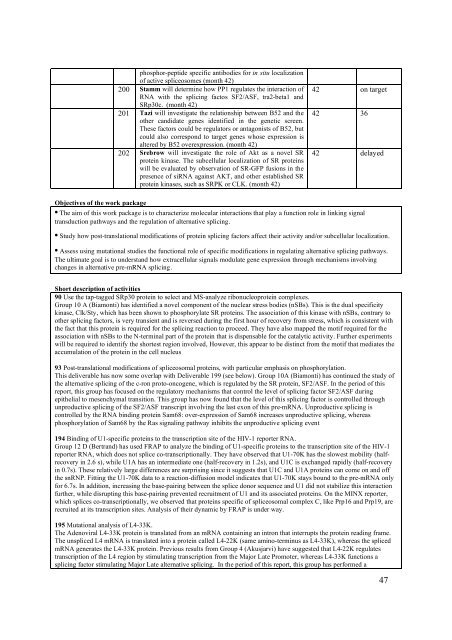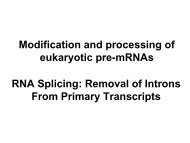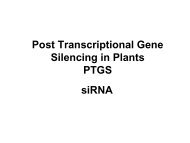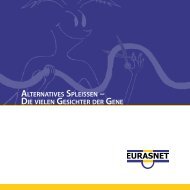Create successful ePaper yourself
Turn your PDF publications into a flip-book with our unique Google optimized e-Paper software.
phosphor-peptide specific antibodies for in situ localizationof active spliceosomes (month 42)200 Stamm will determine how PP1 regulates the interaction ofRNA with the splicing factos SF2/ASF, tra2-beta1 andSRp30c. (month 42)201 Tazi will investigate the relationship between B52 and theother candidate genes identified in the genetic screen.These factors could be regulators or antagonists of B52, butcould also correspond to target genes whose expression isaltered by B52 overexpression. (month 42)202 Srebrow will investigate the role of Akt as a novel SRprotein kinase. The subcellular localization of SR proteinswill be evaluated by observation of SR-GFP fusions in thepresence of siRNA against AKT, and other established SRprotein kinases, such as SRPK or CLK. (month 42)42 on target42 3642 delayedObjectives of the work package• The aim of this work package is to characterize molecular interactions that play a function role in linking signaltransduction pathways and the regulation of alternative splicing.• Study how post-translational modifications of protein splicing factors affect their activity and/or subcellular localization.• Assess using mutational studies the functional role of specific modifications in regulating alternative splicing pathways.The ultimate goal is to understand how extracellular signals modulate gene expression through mechanisms involvingchanges in alternative pre-mRNA splicing.Short description of activities90 Use the tap-tagged SRp30 protein to select and MS-analyze ribonucleoprotein complexes.Group 10 A (Biamonti) has identified a novel component of the nuclear stress bodies (nSBs). This is the dual specificitykinase, Clk/Sty, which has been shown to phosphorylate SR proteins. The association of this kinase with nSBs, contrary toother splicing factors, is very transient and is reversed during the first hour of recovery from stress, which is consistent withthe fact that this protein is required for the splicing reaction to proceed. They have also mapped the motif required for theassociation with nSBs to the N-terminal part of the protein that is dispensable for the catalytic activity. Further experimentswill be required to identify the shortest region involved, However, this appear to be distinct from the motif that mediates theaccumulation of the protein in the cell nucleus93 Post-translational modifications of spliceosomal proteins, with particular emphasis on phosphorylation.This deliverable has now some overlap with Deliverable 199 (see below). Group 10A (Biamonti) has continued the study ofthe alternative splicing of the c-ron proto-oncogene, which is regulated by the SR protein, SF2/ASF. In the period of thisreport, this group has focused on the regulatory mechanisms that control the level of splicing factor SF2/ASF duringepithelial to mesenchymal transition. This group has now found that the level of this splicing factor is controlled throughunproductive splicing of the SF2/ASF transcript involving the last exon of this pre-mRNA. Unproductive splicing iscontrolled by the RNA binding protein Sam68: over-expression of Sam68 increases unproductive splicing, whereasphosphorylation of Sam68 by the Ras signaling pathway inhibits the unproductive splicing event194 Binding of U1-specific proteins to the transcription site of the HIV-1 reporter RNA.Group 12 D (Bertrand) has used FRAP to analyze the binding of U1-specific proteins to the transcription site of the HIV-1reporter RNA, which does not splice co-transcriptionally. They have observed that U1-70K has the slowest mobility (halfrecoveryin 2.6 s), while U1A has an intermediate one (half-recovery in 1.2s), and U1C is exchanged rapidly (half-recoveryin 0.7s). These relatively large differences are surprising since it suggests that U1C and U1A proteins can come on and offthe snRNP. Fitting the U1-70K data to a reaction-diffusion model indicates that U1-70K stays bound to the pre-mRNA onlyfor 6.7s. In addition, increasing the base-pairing between the splice donor sequence and U1 did not stabilize this interactionfurther, while disrupting this base-pairing prevented recruitment of U1 and its associated proteins. On the MINX reporter,which splices co-transcriptionally, we observed that proteins specific of spliceosomal complex C, like Prp16 and Prp19, arerecruited at its transcription sites. Analysis of their dynamic by FRAP is under way.195 Mutational analysis of L4-33K.The Adenoviral L4-33K protein is translated from an mRNA containing an intron that interrupts the protein reading frame.The unspliced L4 mRNA is translated into a protein called L4-22K (same amino-terminus as L4-33K), whereas the splicedmRNA generates the L4-33K protein. Previous results from Group 4 (Akusjarvi) have suggested that L4-22K regulatestranscription of the L4 region by stimulating transcription from the Major Late Promoter, whereas L4-33K functions asplicing factor stimulating Major Late alternative splicing. In the period of this report, this group has performed a47







